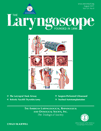Abstract
Objectives:
A number of remote access thyroidectomy techniques have been described in the last several years. These approaches are technically challenging, can be performed on only a limited patient population, and have been associated with significant complications. We describe a novel robotic facelift approach for thyroidectomy and report our initial clinical experience.
Design:
Planned analysis of a prospectively maintained database with institutional review board approval.
Methods:
Robotic facelift thyroidectomy (RFT) was performed on all patients. Demographic and surgical data were obtained and analyzed. Data collected included patient age, gender, body mass index (BMI), pathology, complications, and duration of surgery.
Results:
A total of 18 RFT procedures were undertaken in 14 patients. There were 13 females and 1 male, with a mean age of 33.7 ± 18.1 years (range: 12–70). The mean BMI was 26.9 ± 4.5. The procedures included 13 lobectomies, one bilateral thyroidectomy, and 3 completion thyroidectomies. All but the first procedure was performed on an outpatient basis without use of a drain. There were no conversions to open surgery, no permanent nerve injuries, and no cases of hypoparathyroidism. Operative times ranged from 97 to 193 minutes.
Conclusions:
RFT is a feasible remote access thyroidectomy approach. It appears from our initial experience that it may be performed in a safe and reproducible manner without a drain and on an outpatient basis. Additional clinical experience is warranted to further validate this technique.




